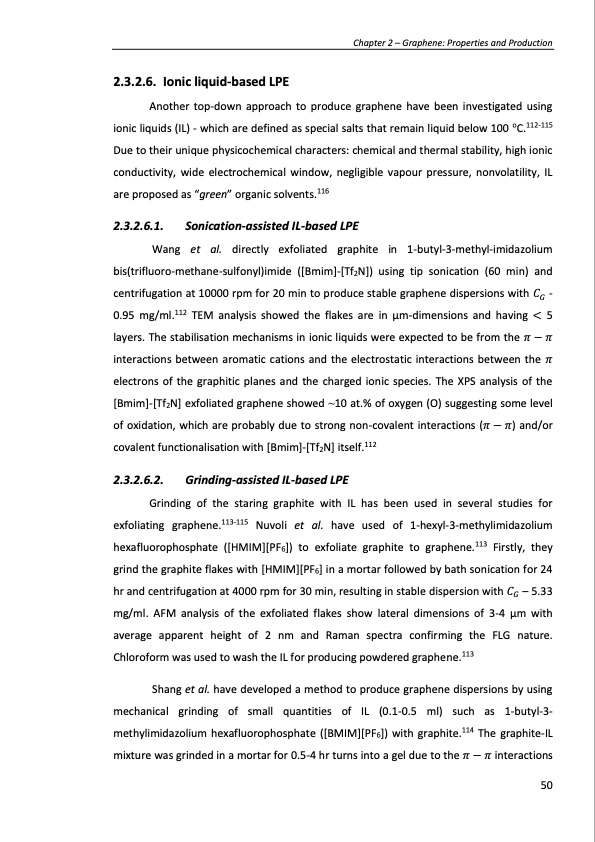
PDF Publication Title:
Text from PDF Page: 050
2.3.2.6. Ionic liquid-based LPE Another top-down approach to produce graphene have been investigated using ionic liquids (IL) - which are defined as special salts that remain liquid below 100 oC.112-115 Due to their unique physicochemical characters: chemical and thermal stability, high ionic conductivity, wide electrochemical window, negligible vapour pressure, nonvolatility, IL are proposed as “green” organic solvents.116 2.3.2.6.1. Sonication-assisted IL-based LPE Wang et al. directly exfoliated graphite in 1-butyl-3-methyl-imidazolium bis(trifluoro-methane-sulfonyl)imide ([Bmim]-[Tf2N]) using tip sonication (60 min) and centrifugation at 10000 rpm for 20 min to produce stable graphene dispersions with 𝐶𝐺 - 0.95 mg/ml.112 TEM analysis showed the flakes are in μm-dimensions and having < 5 layers. The stabilisation mechanisms in ionic liquids were expected to be from the 𝜋 − 𝜋 interactions between aromatic cations and the electrostatic interactions between the 𝜋 electrons of the graphitic planes and the charged ionic species. The XPS analysis of the [Bmim]-[Tf2N] exfoliated graphene showed ~10 at.% of oxygen (O) suggesting some level of oxidation, which are probably due to strong non-covalent interactions (𝜋 − 𝜋) and/or covalent functionalisation with [Bmim]-[Tf2N] itself.112 2.3.2.6.2. Grinding-assisted IL-based LPE Grinding of the staring graphite with IL has been used in several studies for exfoliating graphene.113-115 Nuvoli et al. have used of 1-hexyl-3-methylimidazolium hexafluorophosphate ([HMIM][PF6]) to exfoliate graphite to graphene.113 Firstly, they grind the graphite flakes with [HMIM][PF6] in a mortar followed by bath sonication for 24 hr and centrifugation at 4000 rpm for 30 min, resulting in stable dispersion with 𝐶𝐺 – 5.33 mg/ml. AFM analysis of the exfoliated flakes show lateral dimensions of 3-4 μm with average apparent height of 2 nm and Raman spectra confirming the FLG nature. Chloroform was used to wash the IL for producing powdered graphene.113 Shang et al. have developed a method to produce graphene dispersions by using mechanical grinding of small quantities of IL (0.1-0.5 ml) such as 1-butyl-3- methylimidazolium hexafluorophosphate ([BMIM][PF6]) with graphite.114 The graphite-IL mixture was grinded in a mortar for 0.5-4 hr turns into a gel due to the 𝜋 − 𝜋 interactions Chapter 2 – Graphene: Properties and Production 50PDF Image | PRODUCTION AND APPLICATIONS OF GRAPHENE AND ITS COMPOSITES

PDF Search Title:
PRODUCTION AND APPLICATIONS OF GRAPHENE AND ITS COMPOSITESOriginal File Name Searched:
graphene-production-applications.PDFDIY PDF Search: Google It | Yahoo | Bing
Salgenx Redox Flow Battery Technology: Power up your energy storage game with Salgenx Salt Water Battery. With its advanced technology, the flow battery provides reliable, scalable, and sustainable energy storage for utility-scale projects. Upgrade to a Salgenx flow battery today and take control of your energy future.
| CONTACT TEL: 608-238-6001 Email: greg@infinityturbine.com | RSS | AMP |